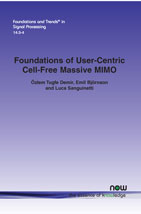Foundations of User-Centric Cell-Free Massive MIMO
By Özlem Tugfe Demir, KTH Royal Institute of Technology and Linköping University, Sweden, ozlemtd@kth.se | Emil Björnson, KTH Royal Institute of Technology and Linköping University, Sweden, emilbjo@kth.se | Luca Sanguinetti, University of Pisa, Italy, luca.sanguinetti@unipi.it
Abstract
Imagine a coverage area where each mobile device is communicating with a preferred set of wireless access points (among many) that are selected based on its needs and cooperate to jointly serve it, instead of creating autonomous cells. This effectively leads to a user-centric post-cellular network architecture, which can resolve many of the interference issues and service-quality variations that appear in cellular networks. This concept is called User-centric Cellfree Massive MIMO (multiple-input multiple-output) and has its roots in the intersection between three technology components: Massive MIMO, coordinated multipoint processing, and ultra-dense networks. The main challenge is to achieve the benefits of cell-free operation in a practically feasible way, with computational complexity and fronthaul requirements that are scalable to enable massively large networks with many mobile devices. This monograph covers the foundations of User-centric Cell-free Massive MIMO, starting from the motivation and mathematical definition. It continues by describing the state-of-the-art signal processing algorithms for channel estimation, uplink data reception, and downlink data transmission with either centralized or distributed implementation. The achievable spectral efficiency is mathematically derived and evaluated numerically using a running example that exposes the impact of various system parameters and algorithmic choices. The fundamental tradeoffs between communication performance, computational complexity, and fronthaul signaling requirements are thoroughly analyzed. Finally, the basic algorithms for pilot assignment, dynamic cooperation cluster formation, and power optimization are provided, while open problems related to these and other resource allocation problems are reviewed. All the numerical examples can be reproduced using the accompanying Matlab code.
Foundations of User-Centric Cell-Free Massive MIMO
Modern day cellular mobile networks use Massive MIMO technology to extend range and service multiple devices within a cell. This has brought tremendous improvements in the high peak data rates that can be handled. Nevertheless, one of the characteristics of this technology is large variations in the quality of service dependent on where the end user is located in any given cell. This becomes increasingly problematic when we are creating a society where wireless access is supposed to be ubiquitous. When payments, navigation, entertainment, and control of autonomous vehicles are all relying on wireless connectivity the primary goal for future mobile networks should not be to increase the peak rates, but the rates that can be guaranteed tothe vast majority of the locations in the geographical coverage area.
The cellular network architecture was not designed for high-rate data services but for low-rate voice services, thus it is time to look beyond the cellular paradigm and make a clean-slate network design that can reach the performance requirements of the future. This monograph considers the cell-free network architecture that is designed to reach the aforementioned goal of uniformly high data rates everywhere.
The authors introduce the concept of a cell-free network before laying out the foundations of what is required to design and build such a network. They cover the foundations of channel estimation, signal processing, pilot assignment, dynamic cooperation cluster formation, poweroptimization, fronthaul signaling, and spectral efficiency evaluation in uplink and downlink under different degrees of cooperation among the access points and arbitrary linear combining and precoding.
This monograph provides the reader with all the fundamental information required to design and build the next generation mobile networks without being hindered by the inherent restrictions of modern cellular-based technology.
